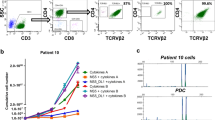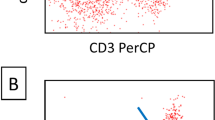Summary
From a plaque biopsy of a patient with mycosis fungoides, two different continuous cell lines were established by including both IL-2 and IL-4 in culture medium. Both continuous cell lines appeared with characteristic chromosome markers after approximately 40 cell population doublings. The initial karyotype recognized in T cells from the skin biopsy was 46,XY and the karyotypes of the continuous cell strains were 46,XY, -18, + i(18q) and another with multiple chromosome aberrations as described in Sezary T-cell leukemia. Phenotyping with monoclonal antibodies and T-cell receptor analysis indicates that the latter cell strain represents a minority of T-cells in the plaque. Due to its many chromosomal aberrations it probably represents the malignant cell, which may be a central cell in the immune stimulation taking place in the skin.
Similar content being viewed by others
References
Abrams, J. T.; Lessin, S.; Ghosh, S. K., et al. A clonal CD4- positive T-cell line established from the blood of a patient with Sezary syndrome. J. Invest. Dermatol. 96:31–37; 1991.
Berger, C. L.; Morrison, S.; Chu, A., et al. Diagnosis of cutaneous T cell lymphoma by use of monoclonal antibodies reactive with tumour-associated antigens. J. Clin. Invest. 70:1205–1215; 1982.
Berger, R.; Bernheim, A. Cytogenetic studies of Sezary cells. Cancer Genet. Cytogenet. 27:79–87; 1987.
Chomczynski, P.; Sacchi, N. Single-step method of RNA isolation by acid guanidinium thiocyanate-phenol-chloroform extraction. Anal. Biochem. 162:156–159; 1987.
Choi, Y.; Kotzin, B.; Herron, L., et al. Interaction ofStaphylococcus aureus toxin “superantigens” with human T-cells. Proc. Natl. Acad. Sci. USA 86:8941–8945; 1989.
Edelson, R. L.: Cutaneous T cell lymphoma: mycosis fungoides, Sezary syndrome, and other variants. J. Am. Acad. Dermatol. 2:89–106; 1980.
Flaxman, B. A.; Zelazny, G.; van Scott, E. J. Nonspecificy of characteristic cells in mycosis fungoides. Arch. Dermatol. 104:141–147; 1971.
Ho, V. S.; Baadsgaard, O.; Elder, J. T., et al. Genotypic analysis of T-cell clones derived from cutaneous T-cell lymphoma demonstrates selective growth of tumor-infiltrating lymphocytes. J. Invest. Dermatol. 95:4–8; 1990.
Kaltoft, K.; Bisballe, S.; Rasmussen, H. F., et al. A continuous T-cell line from a patient with Sezary syndrome. Arch. Dermatol. Res. 279:293–298; 1987.
Kaltoft, K.; Bisballe, S.; Rasmussen, K. Balanced terminal chromosome translocations develop in EBV-derived, but non-immortal cell lines from patients with mycosis fungoides. Acta. Dermato-venereol. Suppl. 120:60–64; 1985.
Knapp, W.; Rieber, P.; Dorken, B. et al., editors. Leucocyte typing IV. England: Oxford University Press; 1990.
Lutzner, M. A.; Hobbs, J. W.; Horvarth, P. Ultrastructure of abnormal cells in Sezary syndrome, mycosis fungoides and parapsoriasis en plaque. Arch. Dermatol. 103:375–386; 1971.
MacKie, R. M.. Initial event in mycosis fungoides is viral infection of epidermal langerhans cells. Lancet 2 (1):283–284; 1981.
Ralfkiaer, E.; Gatter, K. C.; Wantzin, G. L., et al. Immunohistological reactivity pattern of the anti-cutaneous T-cell lymphoma antibody BE2. Br. J. Dermatol. 114:677–684; 1986.
Sterry, W. Mycosis fungoides. Curr. Top. Pathol. 74:167–223; 1985.
Van Scott, E. J.; Kalmanson, J. D. Complete remission of mycosis fungoides lymphoma induced by topical nitrogen mustard (HN2): control of delayed hypersensitivity to HN2 by desensitization and by induction of specific immunological tolerance. Cancer 32:18–30; 1973.
Wechsler, J.; Bagot, M.; Henni, T., et al. Cutaneous pseudolymphomas: immunophenotypical and immunogenotypical studies. In: van Volten, W. A.; Willemze, R.; Vejlsgaard, G. L., et al., eds. Cutaneous lymphoma. Current problems in dermatology, Vol. 19. Basel: Karger 1990:183–188.
Weiss, L. M.; Hu, E.; Wood, G. S., et al. Clonal rearrangements of the T-cell receptor genes in mycosis fungoides and dermatopathic lymphadenopathy. N. Engl. J. Med. 313:539–543; 1985.
Author information
Authors and Affiliations
Rights and permissions
About this article
Cite this article
Kaltoft, K., Bisballe, S., Dyrberg, T. et al. Establishment of two continuous T-cell strains from a single plaque of a patient with mycosis fungoides. In Vitro Cell Dev Biol - Animal 28, 161–167 (1992). https://doi.org/10.1007/BF02631086
Received:
Accepted:
Issue Date:
DOI: https://doi.org/10.1007/BF02631086




